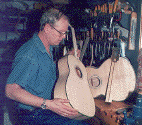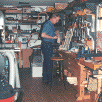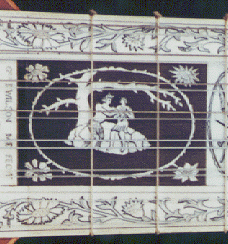
| Famous Guitarmaker Internet World Headquarters George Wilson, Luthier Williamsburg, Virginia, U.S.A. Featured Builder - Summer, 1996 |


| Famous Guitarmaker Internet World Headquarters George Wilson, Luthier Williamsburg, Virginia, U.S.A. Featured Builder - Summer, 1996 |

In 1952 we were sent to Ketchikan, Alaska, and stayed there for six years, except for one year in Sitka. I liked Sitka better since the other kids weren't such a bunch of waterfront roughnecks.
I always wanted to have a shop to work in. When I was in grade school in Ketchikan I attended Deermount School, an old wooden school with about six classrooms. Downstairs there was an old woodshop classroom. The walls were all varnished wood and I managed to get in there a few times to work on a science project. As far as I know, I was the only student who ever tried to use the shop. Hand work in those days was not encouraged, academics were. I was very interested in the sciences, enjoyed reading, and especially such art training as we got. I spent a lot of time drawing. But to me being in that shop was heaven.

"In a town where millions of board feet of spruce were cut each year, I couldn't find decent spruce!" |

|
||
I knew this guitar was bad and soon became obsessed with trying to build a better one. My main problem was a complete lack of information on guitar making. The worst problem was in bending the sides. I had access only to boat building techniques. Steaming and soaking maple only results in bad curling and wrinkling as the sides dried. My own impatience caused problems too. I always had to learn to be more methodical. When I was 13 and 14, like all boys, I wanted bo build everything in one shop session. Today I can tell a student something it took years of effort for me to find out.
Another problem was in getting suitable spruce for the guitar tops. In a town where millions of board feet of spruce were cut each year, I couldn't find decent spruce! The Ketchikan Spruce Mill cut 3 million board feet of flat-cut spruce one year, I remember. It was all sent to rebuild Korea. Of course, these days it would be nothing for me to split spruce from logs, saw and dry it, but back then I couldn't cope with a project like that.
There were plenty of other things to do in Alaska. We built our own house by carrying wood up a long hill all summer while it rained every day -- 11 feet per year! Then we chopped big holes into the first 12 inches of muskeg, after that was solid perma frost to chop to put in the pilings for the foundation. We built our own road too. Half was corduroy road made of cross laid logs over the muskeg, the rest we blasted out of a rocky cliff. Then we added 200 stairs up to the house. After the house was built, I had to get up every morning at 5:00 and carry the day's oil, then walk four miles to the school. After school I'd carry more oil for the night and try to keep several feet of snow off the stairs. This was all done in darkness, as it got light at 11:00 a.m. and dark at 2:00 p.m. Then I had to study each night. I also burned the garbage as thoroughly as possible, but often bears would be pawing through it in the morning, and they left when they were good and ready! My stepfather was always gone on the buoy tender. Oh yes, we buried the pipes four feet deep by hand, but I had to chop open the wooden box where the faucet was at the bottom of the hill, reach though the ice into two feet of water each night to turn off the water or it would freeze. Next morning, the same routine. Needless to say, it was cold, and we did not even have electricity for about two years while building our house. After all these chores were done, I could practice my guitar!
The reason I'm telling this is that while I've voluntarily taught probably 200 students to make guitars and have given away many supplies and tools, I've actually been approached by one or two young men who demanded that I was obligated to teach them. One even wanted to move in and live with me and my wife! I do not respond to these types because they are already totally beyond hope. I don't regret my life, it probably made me more determined to make something of myself. I think it's all tied together. Anyway, the quality of my work is the result of those character-building experiences.
I ended up making several solid-body guitars to get around these problems. I had somehow gotten a pickup and would transfer that pickup to successive guitars along with the tuning pegs. My first amp was an old Rickenbacker that had been a mate for a 1930s Bakelite steel guitar. It must have been about 2 watts, and the electro-magnetic speaker put out about as much 60 cycle hum as it did music.
I gradually overcame the early problems by dint of perseverance and the development of patience. I can tell you that in those days there were no books or suppliers for even simple things like frets. I didn't know other builders, there weren't any in Ketchikan. Every scrape of information about building or obtaining supplies was gold. Encouragement or help was rare, too. Most people thought you were nuts to want to make guitars. Everyone, including my parents, wanted me to be normal and pursue academic studies.
" I had been operating in a vacuum all my life, and now I had a marvelous teacher who encouraged my goals." |

|
||
We moved to Oceania, VA, in 1957, where I went to Princess Anne High School for my junior and senior years. I spent all my spare time in the school shop making guitars. My family still had a modest income and when I made any money, my mother took most of it for school. Therefore, I had hardly any tools and depended upon the school woodworking shop. At least my work was getting better, and I always remained very focused on what I knew I wanted to do. There were few private builders in those days that we few were really pioneers. I finally found a few companies to buy wood from. The only place I knew of to buy parts from in 1958 was the Carvin Guitar Co, in Covina, CA.
I began to make flat-top guitars with this new knowledge, and was able to bend the sides with a propane heated iron I made. I could buy Brazilian rosewood down the street from Old Dominion for $2.50 per board foot, and thought it was expensive!
Will was the best artist I every knew. He wasted no time telling me what trashy work I did, and was really hard on my ego. I couldn't stand him at first, but I had always read a lot, and drawn a lot, especially admiring the old masters. In reality, by most people's standards, I had already accomplished a lot in my guitar making, and I knew it, too. This made Will's attitude hard to take, but I knew he was right because I had eyes to see. I spent the rest of college with Will whenever possible. My work and life were transformed. If other makers had had the good fortune to have a mentor like mine, we would most certainly see much less tasteless trash being touted as great (and collectible) work today.
After graduation I spent six years teaching shop and making guitars. Finally, I was in a financial position to acquire tools and equipment. I was very active and would usually stay after school until 10:00 p.m. to work, although the school was unheated at night and freezing cold in the winter.
I knew teaching was not what I wanted to stay in, at least not on a high school level, because I simply had too much to offer. In 1968 I found out about Penland Craft School in Spruce Pine, NC. I taught there for two summers. It was a great re-awakening for me, as I had once again been working in a vacuum, except for another place: North Carolina School of Performing Arts in Winston-Salem, NC. I took some guitars to the school, where Andrés Segovia taught master classes. Since college my main thrust had been in flamenco and classical guitars. In the last 50s I had been exposed to Sabicas, the world's greatest flamenco guitarist. I had begun to play flamenco at that time, and made hundreds of flamenco and classical guitars. Around 1965 I was able to meet Sabicas at a concert he gave in Charlotte, NC. He liked my work. I built a guitar for him, which he accepted at a concert in Greensboro in 1966. I am the only American builder who succeeded in making a guitar he accepted.
Obviously, by now, I had had a lot of experience in flamenco classical guitars and sold a number of them to students at the School of Performing Arts. I learned more about guitars by seeing Ramirez, Fleta, and other great Spanish-made guitars at the school and in talking to very talented students about how guitars should sound and respond to the player's touch.
My association with the School of Arts exposed me to lutes and harpsichords. I began to delve into those areas, building several lutes and an Italian harpsichord, which I took with me to Penland Craft School in 1968. It was there that I crossed paths with someone who told Colonial Williamsburg about my work.
Colonial Williamsburg was opening a Music Teacher's Shop about 1969. The director of Craft Shops, Earl Soles, needed a harpsichord and several other instruments made for it. He contacted me about making instruments and asked me to Williamsburg to talk about the project. He made it clear that he did not want to hire an instrument maker, but I wanted such a job and somehow knew I would make this visit into a job offer.
I didn't have much to show Earl except one guitar and some pictures of the harpsichord and a recording. Therefore, I sat down and spent a week carving an intricate vine and flower for the back of a lute peghead. This carving was small and very detailed. Earl was so impressed with he carving that he managed to raise money during the next nine months to hire me.
I came to Colonial Williamsburg in 1970 at age 29. For the next year I worked furiously to make an English-style harpsichord for the Music Teacher's Shop. I also had to make instruments new to me, such as viola da gambas, English guitars, spinet harpsichords, and violins, though I had built the latter and repaired hundreds. Being in Colonial Williamsburg meant I now had the resources to study at the Smithsonian, as well as having access to Colonial Williamsburg's own collections. I had time to work only on instruments and was able to improve my work vastly. I acquired books, added to my tools, bought the best materials, and worked constantly in a building not open to the public.
For two years I made instruments for the Music Teacher's Shop, as well as making instruments for the opening of the Musical Instrument Maker's Shop, which would be my shop for the next 16 years. I had to make or buy every tool, instrument, shelf, and workbench that went into the Instrument Maker's Shop and began to make 18th-century style tools to use in the shop. They had to be authentic, so I had to make many of the tools.
We opened the Musical Instrument Maker's Shop in 1972. I hired Marcus Hansen, a former classical guitar student at the North Carolina School of the Arts to work with me. The shop was a great success with the public. It contained a lot of beautiful carving and inlay work to see, so even if you weren't a musician there were plenty of other things to enjoy. We played a little music for the public, also.
In 1974 Colonial Williamsburg filmed the Musical Instrument Maker, now available on video. My shop made a violin and a spinet harpsichord. It is probably the best film on the subject to this day, though the music could have been better. (I had no control over the music).

Earl Soles had been trying to persuade me to become toolmaker for about three years. He had become more and more aware of my various skills, and needed someone to make the numerous tools and other items badly needed in the Historic Area. I became toolmaker in 1986, and my shop is not open to the public.

Since I have been acquiring skills as a toolmaker, as well as machinist equipment, for many years I have been able to make any special tooling I need to streamline my work. My side bending machine is an improvement over the universal side bender. It is made from 3/4" aluminum, has three strong springs to bear back against the waist, and has electrically heated aluminum cauls for bending both waist and cutaway. It uses three 300-watt light bulbs as main heat, and takes only a few minutes to bend a side. Being made of aluminum, not plywood, it won't catch fire. I did not make drawings for this side bender, I just designed it around the universal bender.
The essence of building good sounding instruments is to learn how to select the best pieces of spruce, as well as wood for the backs and sides, and how to thickness and brace each piece to get the best tone. One must proceed scientifically and introduce only one new variable into each new instrument as one seeks to improve tonality.
I make instruments one at a time. I make drawings of the bracing of each one and keep samples of the spruce tops. By this process I can evaluate and improve upon each instrument.
Each instrument I make is unique in appearance, but all have powerful rich tones. I regard each instrument as a separate creative process, and though I could have made mass-produced guitars, I have been interested in learning and have approached guitar making in that way. This has been my method of building for 42 years.

George Wilson's jumbo guitars are priced from $2,500; his archtops are priced from $6,000. For more information about custom instruments, tool design or consultation services on instrument making -- please fax
Directory of our featured builders.
© Featured Builder, Summer, 1996 Famous Guitarmaker Internet World Headquarters, http://www.cybozone.com